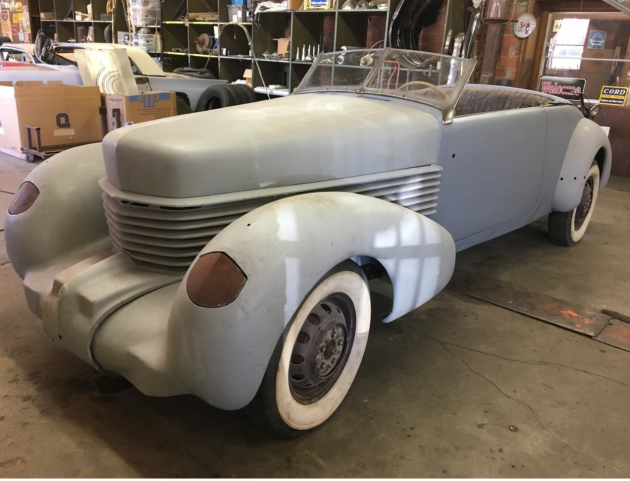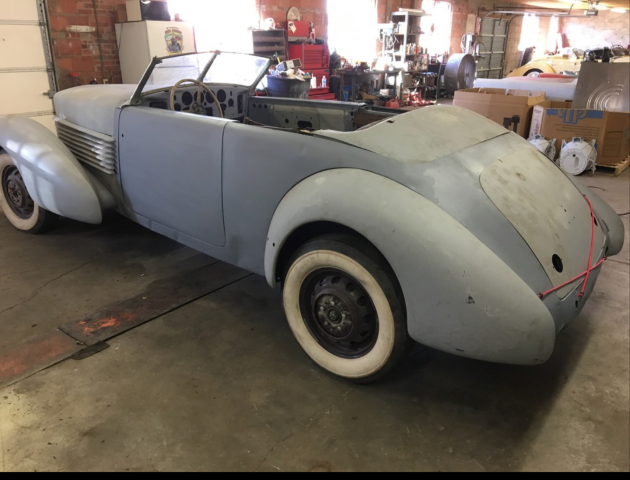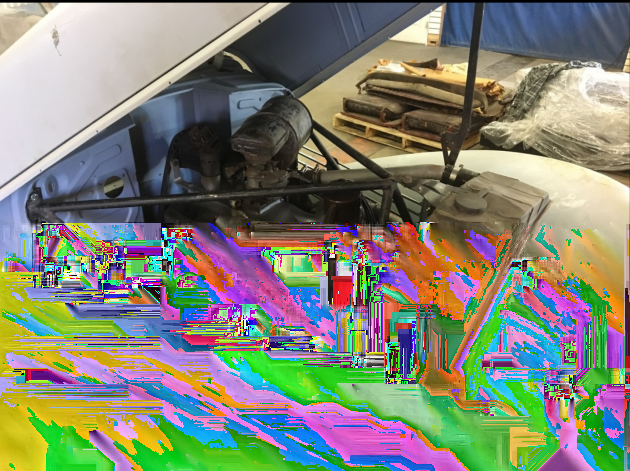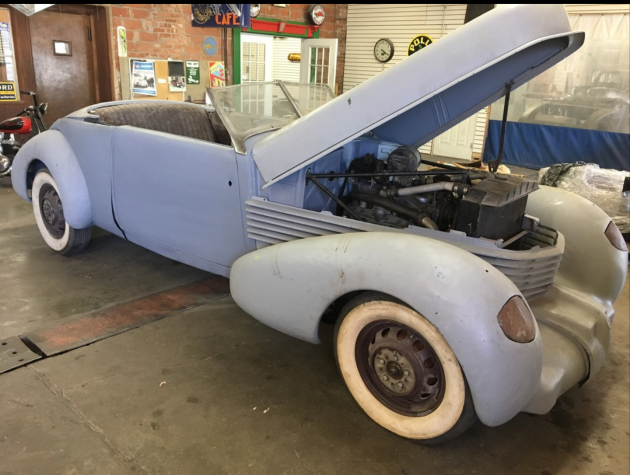Skilled Restorers Only: 1936 Cord 810 Phaeton
In November of 1935, the Auburn Automobile Company shocked the world by displaying at the New York Automobile Show what could reasonably be called the most advanced automobile produced in America. The Cord 810 was a smash hit, and customers crowded around in amazing numbers to see this amazing automobile. Dealers were flooded with orders, and thousands looked forward to seeing their new Cords a few months after the show. Sadly, like most beautiful tings in life, the car had almost fatal flaws that delayed production and, ultimately, frustrated customers. The 810, and the supercharged version dubbed the 812, would go on to be considered a landmark in automobile design, spawning many imitators of its lines and features. Sadly, the car helped to hasten the end of its parent company by not even coming close to meeting sales goals. A first year example of this stunning full classic can be found for sale on eBay in Broken Arrow, Oklahoma. With the buyer having the choice of an immediate purchase at $120,000, or making an offer, that person had better have deep pockets to finish the car to the standard it deserves.
The story of the 810/812, and that of the Auburn Automobile Company’s last days is a sad one. Builders of such incredible cars as the Duesenberg J and SJ, the Auburn 852 boat tailed speedster, and two equally stunning series of front wheel driven Cords, the company fell on hard times during the Depression and struggled financially. Adding to their woes was the fact that all of their cars were at least mid market and above in price, and above average in complexity to build. Luxury car buyers were scarce in the mid 1930s, and most buyers were looking for more practical automobiles. Also, as Elon Musk can tell you, it is not easy being on the cutting edge of design and engineering when you don’t have the resources of major manufacturers.
The first official model year of the 810 Cord was 1936, which would make the car featured here one of 1,174 actually sold during that model year. Leftover cars were sold as 1937 models after continued problems with the transmissions both soured the idea of buying the car in many customer’s minds and slowed down production. Adding a supercharger and working out the bugs in the design helped production climb to 3,000 or so units, but the company needed to sell a lot more than that to survive. Started as the Eckhart Carriage Company in 1874, production ceased and the doors were closed forever in 1937.
The car featured in the pictures above and below is considered a phaeton body style. Phaetons of that era are usually four door convertibles with side curtains, but the Cord phaeton is completely different. Great pains were made to make the top and side windows disappear when folded on this two door automobile. With the top up or down, the elegance of the design is stunning and overwhelming. From the lack of chrome to the hidden headlights, these Cords are a feast for the eyes when properly restored. This one, unfortunately, is a lot of body work away from being completed. A close look at the creases in the body above the rear fenders, the roughness of the panels themselves, and the misalignment of these panels point to this car having had a hard life. My speculation is that the car got rear ended, and the body work that has been done leaves a lot lacking.
Another curious note is that the cowl and under the hood itself is a different color of primer. When you combine that with the fresh paint on the engine itself and the lack of finish detail on the rest of the parts, this one may have been put together from parts restored here and there after the disassembly by the former owner. The seller may have assembled the major pieces to get it into one piece and, thus, sellable condition. In the restoration of a car like this, you always make sure the cowl is painted before putting the engine back in. The seller does state that the restoration started by the previous owner stopped due to health reasons. That person was probably in over their head as well. Cars like this are like buying a palatial old house. One day you wake up and wonder who is the master and who is the slave.
Still, it is an 810 Cord, an automobile that is on the short list of everyone who fancies themselves as an American automotive historian. They have been special since the day they debuted in November of 1935, and there aren’t that many survivors. Yet, owning one is not for the faint of heart or light of wallet. When Hupp Motorcar Company purchased the dies to produce these cars in 1938, they struck a deal with Graham-Paige to produce the sedan version of the car for them as the Hupp(mobile) Skylark, and allowed Graham the rights to use the body to make what they would call the Hollywood. Once again, production delays killed a lot of the orders after the car’s debut. The delays were due largely to the complexity of the sedan’s body, as the car was actually assembled from a number of stampings rather than a few large ones. The cars, to their horror, weren’t well suited to mass production, and required a lot of hand assembly and finishing. While a few convertibles were built as prototypes by Graham and Hupp, they were both on the ropes financially, and producing complicated convertible versions would have only driven them under faster.
So, what does that mean to the potential buyer of this Cord? It is a reminder that these cars are very difficult to restore, and the amount of hand fitting they required when new was one of the reasons that three companies ceased production of automobiles. Complicating this are the ridiculous demands of a concours level restoration and the damage the car has already received. You had better have one hell of a good relationship with the bank to purchase this one. Parts won’t come from NAPA, and Joe’s Body Shop down the street can’t handle the work it will require. There are a few experts out there that are qualified to do the work, but they have long waiting lists and their fees would make a D.C. lawyer blush.
Is it worth restoring? Absolutely! Just know what you are getting into.
P.S. I originally began writing this article a few days ago, as I had some issues to handle for my other job. At that time, the buy it now price was $69,000. It had been up for a couple of days with seemingly no takers. Coming back to the ad, the buy it now price is $120,000. Given that there are ten days to go on the ad at the time of this writing, this one will be interesting to watch!
Auctions Ending Soon
 1971 Ford Mustang Mach 1Bid Now19 hours$7,100
1971 Ford Mustang Mach 1Bid Now19 hours$7,100
 2003 Porsche Boxster SBid Now20 hours$6,000
2003 Porsche Boxster SBid Now20 hours$6,000
 1966 Lincoln ContinentalBid Now22 hours$500
1966 Lincoln ContinentalBid Now22 hours$500
 2000 Jaguar XJ8LBid Now4 days$1,250
2000 Jaguar XJ8LBid Now4 days$1,250
 1977 Datsun 280ZBid Now5 days$275
1977 Datsun 280ZBid Now5 days$275







Comments
Price is out of my league, frankly I’d rather have the Graham Holiwood instead at least it is rear wheel drive and probably a little Cheeper to restore. I do believe I have the skills to restore this car but no where near the budget. Besides I don’t really like Convertables.
Funny you mention Hollywood graham . I still kick myself in not buying one I found ten years back for 15 k. Two door str8 8 inline turbo charged in great shape never restored etc.
Person was a three pack a day person ready to head out and was cleaning out his garage .
Probably would stayed longer but the fellow was still puffing cancer sticks in the garage on oxygen and would not stop upon request. So I left after a quick look !
The turbo had parts machines to make it work again and zero rust etc.
Oh if wishes were horses we would all stocked up on classic Shelbies , yenkos and hemis!
Is that a V8? Thought they had straight 8.
Straight eight
Was a friend of my dads and he was 78 etc
Its was a unrestored
choc color with the cool long front and big fenders etc.
I was car poor with a classic mustang and vete at time but should of bought it anyway
They had a 289 cubic inch Lycoming V8
No wonder the damn thing flew….Lycoming makes airplane engines…pancake 6s and 8s
Lycoming V-8
Very well written analysis, including the Graham/Hupp connection. It’s interesting that E.L. Cord kept his radio and flying interests afloat after bailing on the car units, and a shame, too. Duesenberg may not have been as advanced as Cord, but they were probably the greatest cars ever built in the USA, and Cord was responsible for their demise too, of course.
Throw in a SBC/350turbo,some buckets,add some tail lights and you have that ultimate and worlds most expensive ratrod.lol
My wife is from Chillicothe Ohio. In the early 1980’s we were in her home town and there was a parade. One participent drove a Cord convertible which he had owned for decades. It was shot. The front seats had leopard skin patterned seat covers held on with elastic straps. The front wheels had worn out snow tires.
He stated it was not for sale
Its rare but not worth that much.
Good write up but a waste of time
If I’m not mistaken, this car was for sale in Muskogee, OK for at least 6 or 8 years, with no takers.
I bet you are right. Pretty sure I have seen this car up for sale in the past
This is where it resides at the moment! I have toured this place. Fascinating place and fascinating story about Glenn Pray buying the company and all the leftover NOS parts for the cars, mostly Cords, I believe.
https://www.acdfactory.com/
I want to be constructive in my observations but……….well………..expensive bungee cord
The Graham stamping dies went down on a ship that sank on the way to Russia during WW2. Olds Tornado front axles(go round and round) are a straight across swap for Cord’s.
Interesting write up, true. But I beg to differ about the different primer color under the hood. If you look close, the photos were taken in various light and this just looks like a different panel, in different light, but same color. In the end, who cares? The gray primer would no doubt be the tracer coat to begin working all the depressions and other anomalies while straightening the body. As someone has written–very expensive bungee cord!
This car looks like it could be the donor car for the yellow one in the background supplying the best pieces for that car – leaving the discards bolted on to the example viewed here – – just a guess…